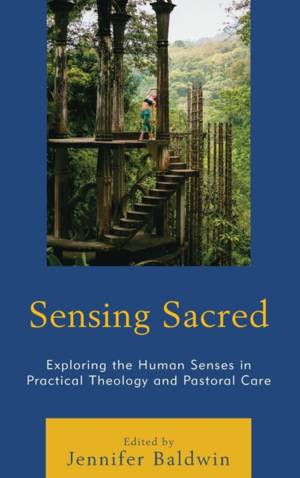
- Afhalen na 1 uur in een winkel met voorraad
- Gratis thuislevering in België vanaf € 30
- Ruim aanbod met 7 miljoen producten
- Afhalen na 1 uur in een winkel met voorraad
- Gratis thuislevering in België vanaf € 30
- Ruim aanbod met 7 miljoen producten
Zoeken
Sensing Sacred
Exploring the Human Senses in Practical Theology and Pastoral Care
€ 198,45
+ 396 punten
Omschrijving
Sensing Sacred is an edited volume that explores the critical intersection of "religion" and "body" through the religious lens of practical theology, with an emphasis on sensation as the embodied means in which human beings know themselves, others, and the divine in the world. The manuscript argues that all human interaction and practice, including religious praxis, engages "body" through at least one of the human senses (touch, smell, hearing, taste, sight, kinestics/proprioception). Unfortunately, body--and, more specifically and ironically, sensation--is eclipsed in contemporary academic scholarship that is inherently bent toward the realm of theory and ideas. This is unfortunate because it neglects bodies, physical or communal, as the repository and generator of culturally conditioned ideas and theory. It is ironic because all knowledge transmission minimally requires several senses including sight, touch, and hearing. Sensing Sacred is organized into two parts. The first section devotes a chapter to each human sense as an avenue of accessing religious experience; while the second section explores religious practices as they specifically focus on one or more senses. The overarching aim of the volume is to explicitly highlight each sense and utilize the theoretical lenses of practical theology to bring to vivid life the connections between essential sensation and religious thinking and practice.
Specificaties
Betrokkenen
- Uitgeverij:
Inhoud
- Aantal bladzijden:
- 206
- Taal:
- Engels
- Reeks:
Eigenschappen
- Productcode (EAN):
- 9781498531238
- Verschijningsdatum:
- 30/08/2016
- Uitvoering:
- Hardcover
- Formaat:
- Genaaid
- Afmetingen:
- 155 mm x 231 mm
- Gewicht:
- 453 g

Alleen bij Standaard Boekhandel
+ 396 punten op je klantenkaart van Standaard Boekhandel
Beoordelingen
We publiceren alleen reviews die voldoen aan de voorwaarden voor reviews. Bekijk onze voorwaarden voor reviews.










